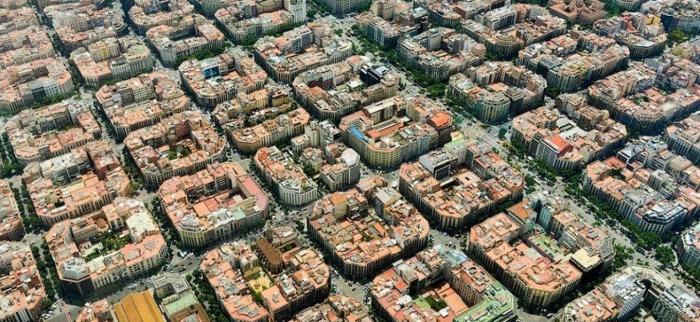The Eixample is extended on the both right and left part of Plaça Catalunya and divided into two zones: Left Eixample and Right Eixample, including also the Sagrada Familia, the area of Sant Antoni and Fort Pienc.
Quadrat dâOr
This area is located between the Carrer Aribau and the Passeig de Sant Joan, on the right side of the district. It is crossed by the Passeig de Gracia, the main artery of the new Eixample. This latter was built in 1860 when the walls surrounding Barcelona were demolished.
The first buildings were major industrial plants such as Elizalde, the first cars and motorbike constructor in Spain.
The Quadrat dâOr (âgolden squareâ) is named like this thanks to the houses located in this district. Indeed, Barcelonaâs bourgeoisie decided to live there. This area is delimited by Carrer Aribau and Passeig de San Juan, Ronda Sant Pere and Diagonal.
Rich families who wanted modern houses with expensive decorations in wood, glass or ceramic gave the Right Eixample its current shape.
Today you can admire houses made by Puig i Cadafalch such as Casa de Les Punxes, Domènech i Montaner with his Casa Lleó Morera and the worldwide famous Casa Batlló and Casa Milá (La Pedrera) of GaudÃ. Must-sees!
Sagrada Familia
The district of the Sagrada Familia, formerly known as El Poblet, a camp district, is located in the Right Eixample and the Quadrat dâOr.
In 1882 began the works of an expiatory temple designed by Francesc de Paula Villar, and continued by Antoni GaudÃ: the expiatory temple of the Sagrada Familia!
This most well known unfinished Barcelonaâs icon gave its name to the district and is nowadays the most visited site of Barcelona. In 2005, the Sagrada Familia was declared âheritage of humanityâ and the works are estimated to be finished in 2028.
For those who want to visit the basilica we suggest to buy the tickets online from the official web page (www.sagradafamilia.cat) to skip the queue!
If you are a Vesping customer you can also ask for the ticket service we provide at no extra cost for you, so that when you rent a motorbike, you will also get your tickets!
The Avenida de Gaudi crosses the Sagrada Familia district, linking the famous basilica to a less known building: the Santa Creu I Sant Pau Hospital. Walk along this pleasant street and admire the Catalan modernismâs representation made by LluÃs Domènech I Montaner.
You shouldnât miss those two masterpieces declared world heritage by the UNESCO.
Left Eixample
The âEsquerra Eixampleâ (âleft extensionâ in Catalan) is the most central part of Barcelona, full of nice spots and with the best âMovidaâ (nightlife).
Admire the Barcelona University on Gran Via de Les Corts Catalanes and its emblematic architecture, take pictures of modern houses and have a walk in the âGaixampleâ of the tolerant city of Barcelona, where flutter the rainbow flag.
Tired of visiting? Take a break and visit the provisional Sant Antoni Market just next to the official one which is currently being renovated. Here you can find farm vegetables, they are specialized in peas and vegetable stews, also you can find a wide variety of seasonal or exotic fruits. After that, have a seat in the Joan Miro park, observe the Woman and Bird sculpture of Joan Miró.
Fort Pienc
The area of Glories and the Estació del Nord offer you a lot to see.
Landing in Barcelona, you may already have spotted the Agbar Tower made by Jean Nouvel from the sky. It is located in this district!
In the Fort Pienc area you will also find the National Theatre of Catalunya located in a Greek temple, and the Auditori, a concert hall hosting the Music Museum and its collection of more than 500 instruments.
After the railway station Estació del Norte closed down in 1972, which is now the main bus station of the city, the piece of land located right behind the station was converted into a lovely little park where you can have a walk before reaching the Arc de Triomf, an impressive gate which was once the entrance of the Universal Exhibition of 1888. You canât miss this monument!

